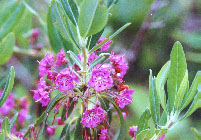- Kalmia
Taxobox
name = "Kalmia"

image_caption = "Kalmia angustifolia"
regnum =Plantae
divisio = Magnoliophyta
classis =Magnoliopsida
ordo =Ericales
familia =Ericaceae
genus = "Kalmia"
genus_authority = L.
subdivision_ranks =Species
subdivision = See text."Kalmia" is a
genus of about 7species ofevergreen shrub s from 0.2-5 m tall, in the familyEricaceae . They are native toNorth America (mainly in the eastern half of the continent) andCuba . They grow inacid ic soils, with different species in wet acid bog habitats ("K. angustifolia, K. polifolia") and dry, sandy soils ("K. ericoides, K. latifolia")."Kalmia" is named after the Finnish botanist
Pehr Kalm , who collected it in eastern North America.The leaves are 2-12 cm long, simple lanceolate, and arranged spirally on the stems. The
flower s are white, pink or purple, in corymbs of 10-50, reminiscent ofRhododendron flowers but flatter, with a star-like calyx of five conjoinedpetal s; each flower is 1-3 cm diameter. Thefruit is a five-lobed capsule, which splits to release the numerous smallseed s.The foliage is toxic if eaten, with
sheep being particularly prone to poisoning, hence the name lambkill used for some of the species. Other names for Kalmia, particularly "Kalmia angustifolia," are sheep-laurel, lamb-kill, calf-kill, kill-kid, and sheep-poison, [http://www.nhest.org/penquis/pentreelist.html Natural History Education, Science, Technology] regarding alternate names, accessed March 30, 2007.] which may be written with or without the hyphen. (See species list below.) "Kid" here refers to a younggoat , not a human child, but the foliage and twigs are toxic to humans as well.It has also been called
spoonwood because Kalm was told by Dutch settlers of North America that Native Americans made spoons from the wood. [http://books.google.com/books?id=aD12iEgGUlgC&pg=PA61&lpg=PA61&dq=spoonwood+spoons&source=web&ots=hDhJ3qQ5FH&sig=0cI_-ay9QZumYMYTv14IzS2I7-4 Plants of Colonial Days] by Raymond Leech Taylor, p. 61. (1996) ISBN 0486294048. Accessed March 30, 2007.] Given its toxicity, this may be folklore rather than scientific fact.Kalmias are popular
garden shrubs, grown for their decorative flowers. They should not be planted where they are accessible to livestock due to the toxicity."Kalmia" species are used as food plants by the
larva e of somelepidoptera n species including "Coleophora kalmiella" which feeds exclusively on "Kalmia".Species:
* "Kalmia angustifolia " L. - Sheep-laurel, Lambkill
* "Kalmia carolina " Small - Carolina Mountain-laurel
* "Kalmia cuneata " Michx. - Whitewicky
* "Kalmia ericoides " Wright - Cuban Kalmia
* "Kalmia hirsuta " Walt. - Hairy Mountain-laurel
* "Kalmia latifolia " L. - Mountain-laurel, Lambkill
* "Kalmia polifolia " Wangenh. - Bog Kalmia, Bog-laurel
** "Kalmia polifolia " var. "microphylla" (Hook.) Rehder - Alpine Bog-laurel, Alpine Mountain-laurelThe related
Kalmiopsis ("Kalmiopsis leachiana") is a rare shrub native to theSiskiyou Mountains of southwestOregon .References
External links
* [http://www.pieris.eu Info about Kalmia latifolia]
* [http://www.kalmia-society.org European Kalmia Society]
* [http://www.kalmia.info A German hybridizer]
Wikimedia Foundation. 2010.
